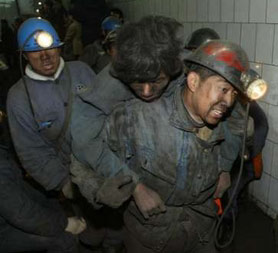|
Gov't steps up efforts to curb mine accidents
By Liu Li (China Daily)
Updated: 2005-12-28 06:12
Vice-Premier Zeng Peiyan told top legislators yesterday that the central
government will take action to tackle coal mine safety.
"Safety has become a top concern for the State Council in economic and social
development," Zeng said yesterday in a report at the ongoing session of the
Standing Committee of the National People's Congress.

A rescuer carries
an injured miner after a coal mine blast in Qitaihe, in northeast China's
Heilongjiang province, November 28, 2005. The blast killed 134 miners.
[Reuters] |
Two coal mine accidents that killed over 100 each time occurred within 10
days in late November and early December in Northeast China's Heilongjiang
Province and North China's Hebei Province.
According to Zeng, China, the world biggest raw coal producer, has adopted
seven major measures to curb accidents:
To strengthen the discovery of hidden dangers in coal mines, and improve
supervision of mines that stop production due to lack of safety guarantee.
To shut down those coal mines which do not meet with safety requirements even
after improvements.
To regulate coal mine mergers.
To tighten supervision over construction of coal mine projects.
To cure the problem of high gas content in coal mines.
To strengthen punishment.
To ascertain responsibilities of officials after accidents.
According to Zeng's report on the current resource and safety conditions,
energy supply has become a serious restriction on China's economic and social
development.
"To increase investment in safety is also a must," Zeng said.
Coal, electricity and oil are in short supply, and energy consumption is not
efficient enough.
"Contradiction between resource supply and demand will continue for a long
time," he said.
Given this problem, China will actively participate in global oil, gas and
coal exploration and co-operation, according to Zeng.
However, he stressed, "We will mainly rely on domestic resource supply."
The construction of 13 large-scale coal production bases including Shendong,
along the boundary between Shaanxi Province and Inner Mongolia Autonomous
Region, and Huanglong in Shaanxi will be accelerated.
Meanwhile, construction on projects for new and renewable energy will also be
accelerated.
Several nuclear power plants of millions of kilowatts will be established,
and more wind power and solar energy will be exploited.
It is expected that renewable resources will contribute 15 per cent of the
total resource supply in 2020, up from the current 7 per cent, according to
Zeng.
According to statistics last year, China was the second biggest resource
producer in the world, with production volume of 1.85 billion tons of standard
coal.
(China Daily 12/28/2005 page2)
|